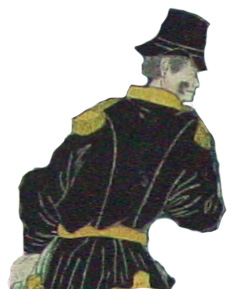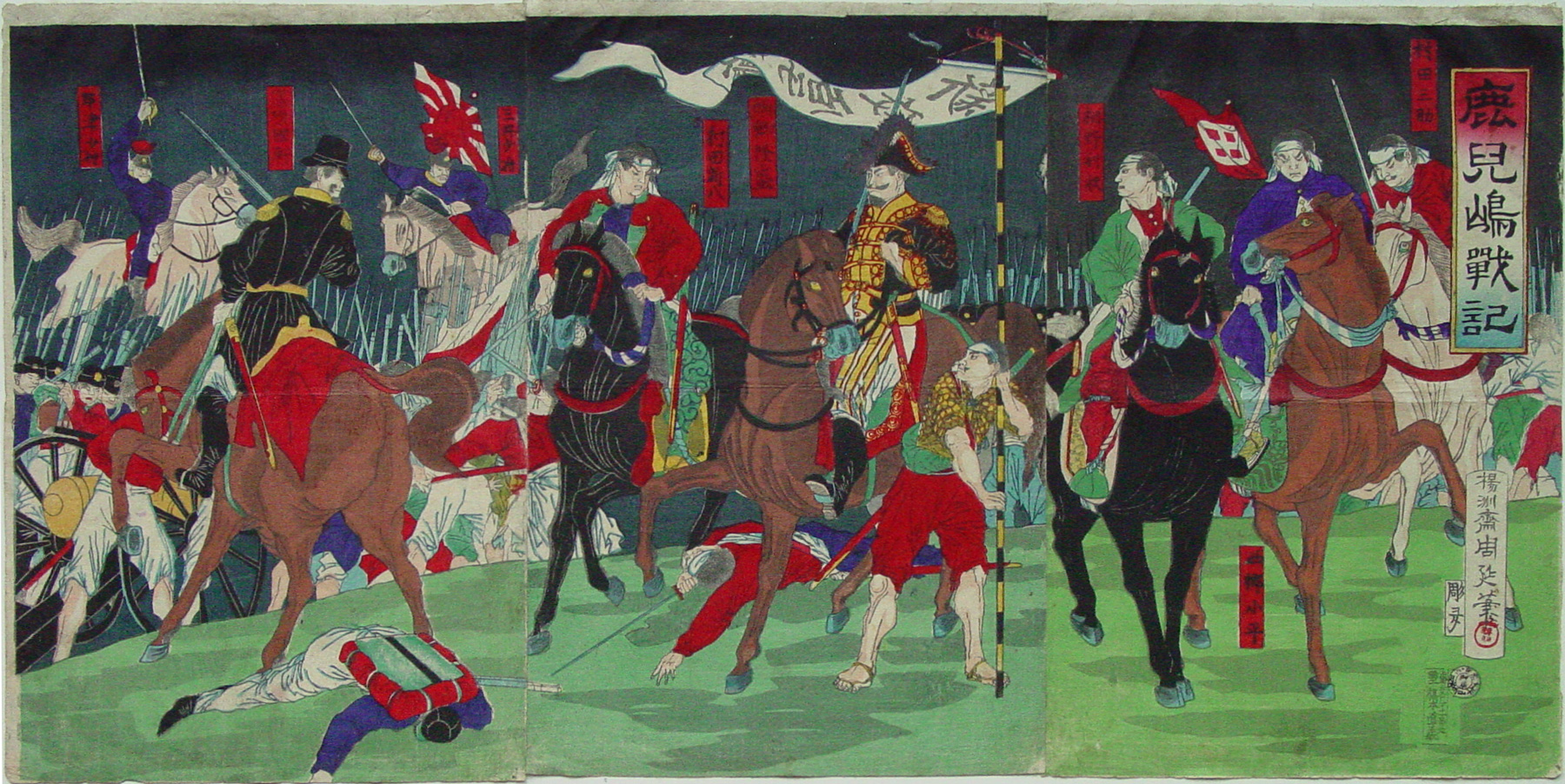About This Print
Saigō Takamori 西郷隆盛 is front and center upon horseback in this print depicting one of the engagements associated with the siege of Kumamoto Castle in Kagoshima during the 1877 Satsuma Rebellion. A banner with a slogan "A New Government, Rich in Virtue", fabricated by woodblock artists and perpetuated by the press, is carried by an unidentified rebel. Saigō's comrades pictured in the print on horseback, from left to right, are Shinohara Kunimoto 篠原国幹, Murata Shinpachi 村田新八, Kirino Toshiaki 桐野利秋, Saigō Kokei 西郷小平 (Takamori's younger brother) and Murata Sansuke 村田三助.By the time this print was issued on March 23 the war had been raging for one month. The first major engagement was the siege of Kumamoto Castle by the rebels. As both sides sent in reinforcements the rebels entrenched themselves on a strategic hilltop and a fierce battle involving some 20,000 men, evenly divided between the armies, ensued with 4,000 casualties on each side. On March 20 the better supplied government troops seized the hill, forcing the rebels to retreat.
Kagoshima Senki - War Chronicles of Kagoshima
Chikanobu designed at least 45 triptych prints that "documented" the rebellion in Kagoshima. At least ten of them were titled "Kagoshima senki" ("war chronicle") and they read like breaking news stories. At least eight different publishers contracted with Chikanobu, as each publisher rushed to get the latest news out to an eager public.
1The Last Samurai: The Life and Battles of Saigo Takamori, Mark Ravina, John Wiley & Sons, Inc., 2004, p. 206.
Strange Uniforms
Source: Emperor of Japan: Meiji and His World, 1852-1912, Donald Keene, Columbia University Press, 2002, p.278.
last revision:
A Fabricated Slogan - "A New Government, Rich in Virtue"
Mark Ravina in his book The Last Samurai explains that Saigo's followers "lacked any common ideology." He goes on to explain:| Within weeks...the popular press had created a slogan for Saigo: Shinsei kotoku (A New Government, Rich in Virtue). The origins of the slogan are unclear, but on March 3 the Yubin hochi shinbun newspaper reported that Saigo was using the slogan on his battle flags. There were no such flags: Saigo's pennants were simple variations on the Shimazu family crest. The slogan was entirely a creation of woodblock print (nishikie) artists, which the newspaper mistakenly construed as fact. The slogan, which appeared in scores of different prints, became a cautious way for artists to show support for Saigo without violating Meiji press law. Artists dutifully described Saigo as a treacherous rebel in prose but then drew him in heroic poses with his valiant slogan.1 |
Strange Uniforms
Source: Emperor of Japan: Meiji and His World, 1852-1912, Donald Keene, Columbia University Press, 2002, p.278.
 | Although Saigō's troops had been well trained and maintained discipline, the army must have presented a curious appearance. Saigō, Kirino, Shinohara, and the other top-ranking officers who had not resigned their commissions in the government forces wore the same uniforms as did the men they would fight. Others of Saigō's officers wore naval uniforms, police uniforms, or the dress of civil servants. Officers wore a white armband indicating the unit to which they were attached, and a crepe silk or white cotton sash over their coats. A sword dangled from their left hip, and they carried bright red flags in their right hand. The costumes worn by ordinary soldiers were even stranger. Strangest of all was Murata Shimpachi (left), recently returned from abroad, who rode into battle attired in a swallow-tail coat and derby. |
Print Details
| IHL Catalog | #449 |
| Title or Description | Kagoshima senki 鹿児嶋戦記 Record of the war in Kagoshima [also translated as Description of the Fighting at Kagoshima and Chronicles of the War against Kagoshima] |
| Series | |
| Artist | Yōshū Chikanobu (1838-1912) |
| Signature |  |
| Seal | Toshidama seal (center characters unread) |
| Publication Date |  |
| Publisher | 太田与平 Ōta Yohei  |
| Carver |  |
| Impression | excellent |
| Colors | excellent |
| Condition | fair – three panels joined; remnants of prior mounting along top margin; light soiling throughout; minor damage along bottom margin; full-size untrimmed sheets. |
| Genre | ukiyo-e; senso-e |
| Miscellaneous | |
| Format | vertical oban triptych |
| H x W Paper | 14 3/8 x 28 7/8 in. (36.5 x 73.3 cm) |
| Literature | |
| Collections This Print | Waseda University Library チ05 04178 0011 |
4/19/2020
3/7/2020
1/6/2019


